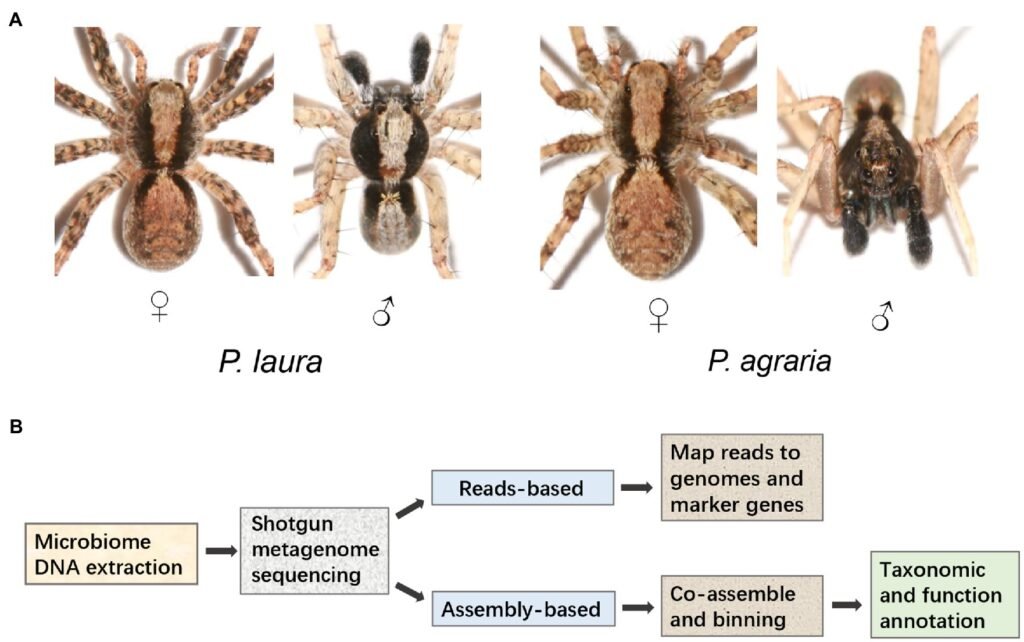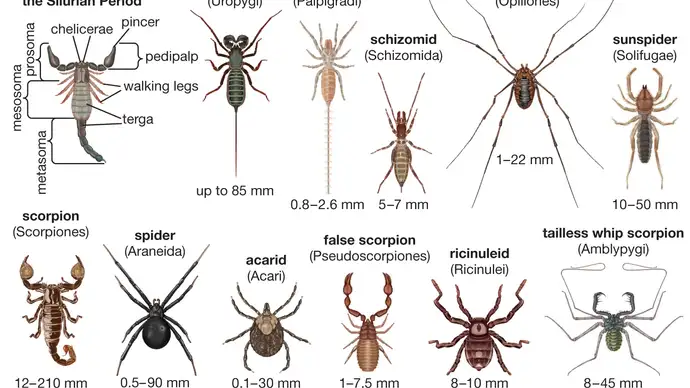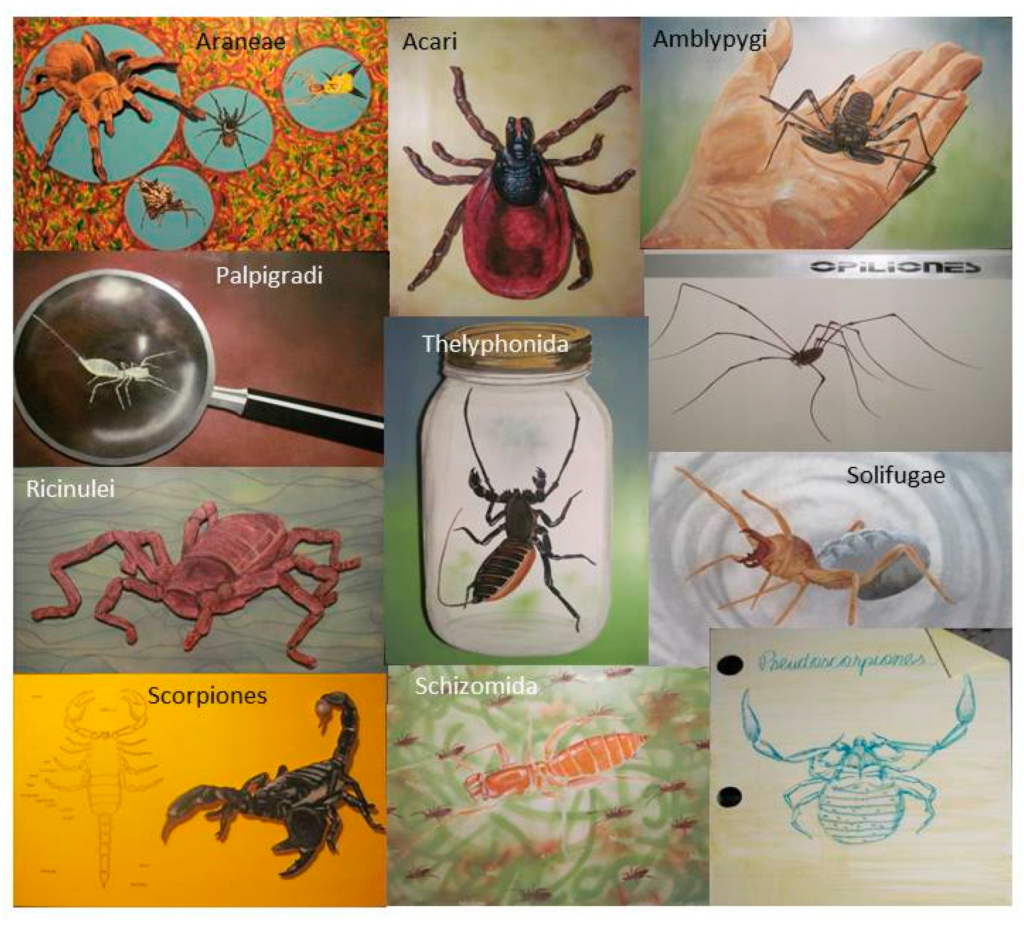Have you ever wondered just how big or small spiders can get compared to other arachnids? In the fascinating realm of the arachnid world, size variations abound and each species brings its own unique dimensions. From the tiny harvestman with its spindly legs to the imposing tarantula with its massive frame, these arachnids showcase a wide range of sizes that are sure to captivate your curiosity. Join us as we embark on a journey through the diverse world of arachnids, exploring their intriguing size variations and uncovering the wonders they hold.

This image is property of www.frontiersin.org.
1. Introduction
Welcome to our comprehensive article on exploring the size variations among arachnids! In this article, we will delve into the fascinating world of arachnids and their diverse range of sizes. From the largest spiders to the smallest harvestmen, we will explore the factors that influence the size variations among these intriguing creatures. Join us as we uncover the adaptations, evolutionary advantages, and ecological significance of arachnid sizes. Let’s get started!
2. Overview of Arachnids
2.1 What are arachnids?
Arachnids are a diverse group of joint-legged invertebrates that belong to the class Arachnida. This class includes spiders, scorpions, harvestmen, mites, ticks, and sun spiders. Arachnids are characterized by having two main body segments— the cephalothorax and the abdomen—and four pairs of legs. They play crucial roles in various ecosystems by serving as both predators and decomposers.
2.2 Major groups of arachnids
Arachnids are organized into several major groups, each with its own unique characteristics. The major groups of arachnids include spiders (order Araneae), scorpions (order Scorpiones), harvestmen (order Opiliones), mites, and ticks (subclass Acari), and sun spiders (order Solifugae). While these groups share certain traits, they also exhibit distinct adaptations and behaviors that contribute to size variations.

This image is property of static.wikia.nocookie.net.
3. The Size Range of Arachnids
3.1 Largest arachnids
Among arachnids, some species have evolved into giants, boasting impressive sizes that captivate our fascination. One notable example is the Goliath bird-eater spider (Theraphosa blondi), which holds the title of the world’s largest spider by both mass and leg span. These formidable creatures can have a leg span of up to 30 centimeters and weigh over 170 grams. Other arachnids like the emperor scorpion (Pandinus imperator) and the giant whip scorpion (Mastigoproctus giganteus) also rank among the largest arachnids.
3.2 Smallest arachnids
While some arachnids may be massive, others are remarkably tiny. Among the smallest arachnids are the members of the family Symphytognathidae, which include spiders measuring only a few millimeters in length. Mites and ticks also exhibit a wide range of sizes, with some species measuring less than 0.1 millimeters. For comparison, these tiny creatures can be smaller than the head of a pin!
3.3 Factors influencing size variations
Several factors contribute to the size variations among arachnids. One crucial factor is the availability of resources, such as food and shelter. Arachnids in environments with abundant resources tend to grow larger, while those in resource-limited environments may remain small. Additionally, genetic factors and the trade-off between adaptive traits, such as mobility and reproductive capacity, can also influence size variations among arachnids.
4. Size Comparisons Among Arachnid Orders
4.1 Araneae (Spiders)
Spiders, belonging to the order Araneae, exhibit a wide range of sizes within their diverse families. Some families, like the theraphosids, contain species with both large and small spiders. The largest spiders among the Araneae order include the previously mentioned Goliath bird-eater spider, while the smallest spiders can be found among the sheet weaver spiders (Linyphiidae) and some species of jumping spiders (Salticidae).
4.1.1 Spider size variations within families
Even within families, there can be significant variations in spider sizes. For example, the family Theridiidae, which includes the black widow and cobweb spiders, contains species that range from small to medium-sized. This variation often depends on factors such as habitat, prey availability, and ecological niche.
4.1.2 Largest spiders
The title of the largest spider often goes to the theraphosids, a family known for their impressive size and strength. In addition to the Goliath bird-eater spider, several other giant tarantulas, such as the Brazilian salmon pink tarantula (Lasiodora parahybana) and the Colombian giant tarantula (Megaphobema robustum), rank among the largest spiders.
4.1.3 Smallest spiders
Among the smallest spiders are the representatives of the family Linyphiidae, commonly known as sheet weaver spiders or money spiders. These tiny spiders often construct intricate sheet-like webs and can be found in various habitats worldwide. Additionally, certain species of jumping spiders, known for their acrobatic hunting behaviors, also exhibit small sizes.
4.2 Scorpiones (Scorpions)
Scorpions, belonging to the order Scorpiones, are nocturnal arachnids known for their venomous stingers and distinctive appearance. While scorpions often have similar body plans, they exhibit variations in size within their families.
4.2.1 Scorpion size variations within families
Within scorpion families, size variations can be observed. For example, the family Buthidae, which includes many highly venomous scorpions, showcases species ranging from the smaller deathstalkers (Leiurus) to the larger emperor scorpions (Pandinus).
4.2.2 Largest scorpions
The largest scorpions are often found within the family Scorpionidae, which includes the desert hairy scorpions (Hadrurus) and the forest scorpions (Opistophthalmus). These scorpions can reach lengths exceeding 20 centimeters, making them impressive in both size and appearance.
4.2.3 Smallest scorpions
When it comes to smaller scorpions, the family Microcharmidae stands out. These tiny scorpions are often less than 2 centimeters in length and are known for their delicate appearance. Despite their small size, they still possess venom, albeit less potent than their larger relatives.
4.3 Opiliones (Harvestmen)
Harvestmen, or daddy longlegs, belong to the order Opiliones. These arachnids are characterized by their long legs and peculiar body shape. While harvestmen are generally smaller than spiders and scorpions, they also exhibit size variations within their families.
4.3.1 Harvestmen size variations within families
Size variations within harvestmen families can be observed, especially in families such as Phalangiidae and Sclerosomatidae. Some species within these families can reach sizes comparable to smaller spiders, while others remain much smaller in comparison.
4.3.2 Largest harvestmen
Among the largest harvestmen are the representatives of the family Phalangiidae. Some species within this family, such as Leiobunum vittatum, can have leg spans of 10 centimeters or more.
4.3.3 Smallest harvestmen
Conversely, some of the smallest harvestmen can be found within the family Sclerosomatidae. These tiny arachnids often have leg spans of only a few millimeters.
4.4 Acari (Mites and Ticks)
Mites and ticks, belonging to the subclass Acari, comprise a vast and incredibly diverse group of arachnids. Their sizes can range from almost microscopic to larger, depending on various factors.
4.4.1 Mite and tick size variations within families
Mites and ticks exhibit significant size variations within their respective families. For example, the family Trombiculidae, commonly known as chiggers, includes species that can be as small as 0.1 millimeters but can still cause discomfort due to their parasitic habits.
4.4.2 Largest mites and ticks
The largest mites and ticks often fall under the family Ixodidae, which includes the well-known hard ticks. Some species within this family, such as the American dog tick (Dermacentor variabilis), can grow up to 15 millimeters in length when engorged with blood.
4.4.3 Smallest mites and ticks
At the other end of the size spectrum are the oribatid mites, often referred to as moss mites or beetle mites. These mites are typically less than a millimeter in length and can be found in various habitats, including soil, leaf litter, and moss.
4.5 Solifugae (Sun spiders)
Sun spiders, also known as camel spiders or wind scorpions, are part of the order Solifugae. Despite their name, they are not true spiders or scorpions but possess their own unique characteristics and variations in size.
4.5.1 Sun spider size variations within families
The family Solpugidae, which includes the majority of sun spider species, displays size variations within its members. Some species, such as the Egyptian giant solpugid (Galeodes arabs), can reach sizes exceeding 10 centimeters in length.
4.5.2 Largest sun spiders
Among the largest sun spiders are the representatives of the genus Galeodes. These impressive creatures may have leg spans of over 20 centimeters and can appear quite intimidating, though they are generally harmless to humans.
4.5.3 Smallest sun spiders
Conversely, within the family Eremobatidae, one can find smaller sun spiders. These diminutive arachnids, often measuring only a few centimeters in length, are still formidable predators within their respective habitats.

This image is property of upload.wikimedia.org.
5. Adaptations of Arachnid Sizes
5.1 Hunting strategies
Arachnids have evolved a variety of hunting strategies that are closely tied to their size. Larger arachnids, such as the Goliath bird-eater spider or the emperor scorpion, rely on their size and strength to capture prey. Their larger bodies allow them to overpower and subdue larger prey items. In contrast, smaller arachnids, like sheet weaver spiders or some mites, employ intricate web-building techniques to catch prey that matches their size.
5.2 Reproduction and mating
Size variations among arachnids can also play a crucial role in reproduction and mating. In some species, larger males may have better chances of attracting mates, either through direct competition with other males or through elaborate courtship displays. Conversely, smaller arachnids may employ alternative reproductive strategies, such as producing more offspring at a smaller size, increasing their chances of survival and reproductive success.
5.3 Ecological niches
Arachnid sizes are often closely linked to the ecological niches they occupy. Different sizes enable arachnids to exploit various resources and habitats. The larger arachnids often occupy top predator positions in their ecosystems, regulating prey populations and playing essential roles in maintaining ecological balance. Smaller arachnids, on the other hand, may occupy different niches, such as leaf litter or underground habitats, where their size provides advantages in movement and resource acquisition.
6. Implications of Size Variations
6.1 Evolutionary advantages
Size variations among arachnids provide evolutionary advantages in different contexts. Larger size can confer greater strength, allowing for the capture of larger prey or defense against predators. Additionally, larger arachnids may have longer lifespans and increased reproductive capabilities. Smaller sizes, on the other hand, may provide advantages such as improved agility, increased population densities, and better camouflage.
6.2 Ecological significance
The size variations among arachnids have significant ecological significance. Arachnids, as predators and decomposers, influence the structure and dynamics of ecosystems. The presence of both small and large arachnids ensures a balanced food web and nutrient cycling. Additionally, their diverse sizes contribute to the overall biodiversity and abundance of arachnids in different habitats, making them essential components of various ecosystems worldwide.

This image is property of pub.mdpi-res.com.
7. Conclusion
In conclusion, the size variations among arachnids are a testament to the incredible diversity and adaptability of these fascinating creatures. From the largest spiders to the smallest mites and ticks, arachnids have evolved to fill a wide range of ecological roles. Size influences their hunting strategies, mating behaviors, and resource utilization, while also shaping their evolutionary advantages and ecological significance. By exploring the size variations among arachnids, we gain a deeper understanding of their remarkable adaptations and the vital roles they play in maintaining the balance of our ecosystems. So, the next time you encounter an arachnid, take a moment to appreciate the incredible diversity of sizes within this remarkable group of creatures.
